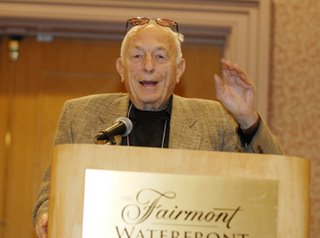It was such a thrill for me to finally see and listen to John Friedmann in person deliver a speech last month. The urban planning guru received the 2006 UN-HABITAT Award and gave the jam-packed inaugural UN-HABITAT lecture at the World Urban Forum in
Friedmann’s speech, titled The Wealth of Cities: Towards an assets-based development of urbanizing regions, was the ultimate progressive’s answer as to how cities should (choose to) develop amidst all the pressure “to make themselves into commodities for the capital market” and “to frustrate themselves to the power of global capital.” He said all this is useless as “when capital finds more attractive regions, they will leave the city, leaving abandoned factories…” Friedmann therefore argued for “endogenous, genuine development.”
- Human assets: encompassing those that support a person’s right to live: housing, education, health
- Social assets: civil society – or the bonds that tie people together, be it via religion, sport, music, hobby, what have you.
- Cultural assets: includes physical heritage such as buildings and places, but also those of “everyday life vibrancy,” including popular traditions and festive occasions.
- Intellectual & creative assets: intellectuality and creativity must be nurtured; there has to be “a freedom to create;” “creativity can’t be commanded, but creative work must have public support.”
- Natural assets: including forests, rivers, and the urban fringe. The city needs them as they are part of the urban as well (Friedmann’s words were “where does the city end and the countryside begin?”)
- Environmental assets: conditions/things that make living in the city bearable physically, such quality of water, air, space.
- Urban infrastructure assets: including urban transportation and utilities. The question is whether to invest in infrastructures of the rich minority (the 15% automobile class) or the poor(er) majority (the 80% transit and walking class). [note: I’m not sure to which city Friedmann was referencing these numbers, but you get the point]
 technorati tags: cities, development, urban, political-economy
technorati tags: cities, development, urban, political-economy

No comments:
Post a Comment